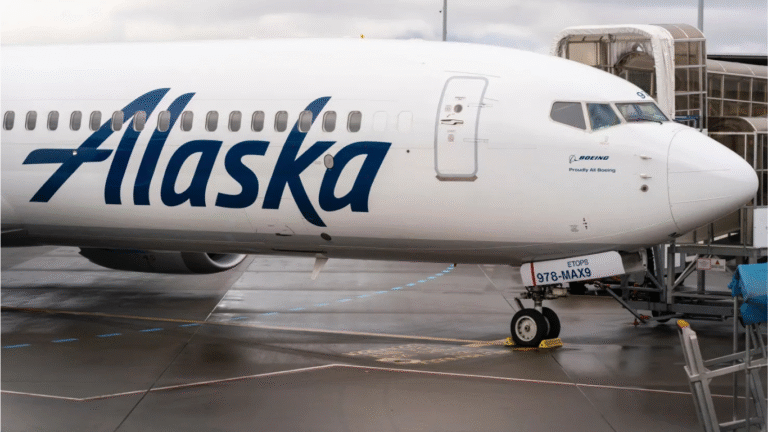A Widespread Disruption Across the Nation
On Thursday, October 23, 2025, Alaska Airlines faced a major operational breakdown that brought its entire network to a halt. The Alaska Airlines IT outage began around 3:30 p.m. Pacific Time, following a failure at the airline’s primary data center. Within hours, the malfunction led to a systemwide ground stop affecting all Alaska Airlines and Horizon Air flights across the United States. The Federal Aviation Administration confirmed that the halt was requested directly by the airline to maintain safety while technicians investigated the problem.
The disruption was massive more than 229 flights were canceled by late evening, while many others experienced extensive delays. Passengers in Seattle, Portland, Los Angeles, Anchorage, and other major hubs faced long lines, rescheduled flights, and uncertainty about when operations would resume. By 11:30 p.m. Pacific Time, the ground stop was lifted, but the aftermath of the Alaska Airlines IT outage continued well into the next day as crews and aircraft were repositioned across the network.
The Cause of the Outage
According to official statements, the Alaska Airlines IT outage originated from a failure at the company’s primary data center, which impacted several mission-critical systems responsible for flight operations, crew assignments, and scheduling. Importantly, the airline clarified that the outage was not caused by a cybersecurity event or external interference. Rather, it stemmed from a technical malfunction within internal systems that temporarily disrupted synchronization between flight management platforms.
Hawaiian Airlines, which operates independently of Alaska’s IT infrastructure, was not affected by the failure. The company emphasized that flight safety was never at risk, even as its technology infrastructure suffered major setbacks. In its public statement, Alaska Airlines explained:
“The IT outage does not affect Hawaiian Airlines flights. The issue began around 3:30 p.m. on Thursday, Oct. 23, with a failure at our primary data center. The safety of our flights was never compromised.”
While this reassurance calmed some concerns, the outage exposed how deeply modern airline operations depend on uninterrupted technology systems. The Alaska Airlines IT outage quickly became a case study in the vulnerability of digital aviation infrastructure.
The Immediate Response from Alaska Airlines
As systems went offline, Alaska Airlines took immediate steps to ensure passenger safety and transparency. The company initiated a full ground stop halting all flights until it could verify that communications, scheduling, and dispatch systems were stable. By early evening, the airline began issuing statements across multiple channels, acknowledging the Alaska Airlines IT outage and informing passengers to check flight statuses before leaving for the airport.
At 7:00 p.m. Pacific Time, Alaska Airlines publicly confirmed that the outage was ongoing and that both Alaska and Horizon Air operations were affected. As of 12:15 a.m. Pacific Time on Friday, the airline announced that operations had been restored, with the ground stop lifted. However, it warned that further disruptions were expected as aircraft and crews were repositioned.
A flexible travel policy was activated, allowing passengers to rebook or cancel flights without penalty. The airline’s message to customers was clear: patience and understanding were appreciated as teams worked “to get operations back on track as quickly and safely as possible.”
This proactive communication strategy helped mitigate confusion during the Alaska Airlines IT outage, with frequent updates shared through press releases, social media posts, and email alerts.
Nationwide Impact on Travelers
The Alaska Airlines IT outage left thousands of travelers stranded across the U.S. In major airports like Seattle-Tacoma International (SEA), passengers described scenes of frustration as flights were grounded with little initial information. Many travelers were already through security when announcements of cancellations began, forcing them to return to ticketing areas for assistance.
Long queues formed at customer service counters, with staff manually rebooking flights using backup systems. For many passengers, digital platforms mobile apps and the website were also impacted, preventing them from accessing flight updates or boarding passes.
Social media quickly filled with photos and videos from crowded terminals. One traveler posted:
“No flights, no updates, and the lines just keep growing. The staff are doing their best, but everyone’s frustrated.”
Despite the chaos, Alaska Airlines employees received praise for maintaining calm and professionalism. Airport agents used manual processes to print boarding passes and confirm bookings while IT teams worked behind the scenes to restore connectivity. The flexible rebooking policy, issued within hours of the Alaska Airlines IT outage, gave customers additional peace of mind.
Flight Cancellations and Operational Fallout
By late Thursday night, the Alaska Airlines IT outage had resulted in the cancellation of more than 229 flights, with hundreds more delayed nationwide. As the airline worked to restore systems, flight crews were left out of position, aircraft were scattered across the network, and scheduling backlogs accumulated.
Even after the ground stop was lifted at 11:30 p.m., disruptions persisted well into Friday as the airline scrambled to reposition planes and personnel. Analysts noted that it could take up to 48 hours for operations to fully normalize. Airports including Anchorage, San Francisco, and Los Angeles reported residual delays affecting early morning departures.
The airline’s swift decision to halt all flights, though costly, was praised by aviation experts as a sign of prioritizing safety over profit. “Grounding the fleet ensures no aircraft departs without complete and verified operational data,” said one industry analyst. “It’s a prudent move that demonstrates responsibility amid crisis.”
The Financial and Reputational Impact
The Alaska Airlines IT outage has financial implications that extend beyond immediate cancellations. Each grounded aircraft represents lost revenue, logistical expenses, and customer service costs. The airline must also handle compensation for hotel accommodations, meal vouchers, and rebooking fees.
This marks the second time in 2025 that Alaska Airlines has experienced an IT failure of this magnitude. A similar incident in July halted operations for several hours, prompting a downward revision of the company’s profit outlook for that quarter. Repeated outages can erode public trust and investor confidence, particularly when they disrupt thousands of passengers in a competitive travel market.
Market observers predict that Alaska Airlines may face scrutiny from regulators and shareholders regarding its IT infrastructure. The company’s continued transparency during the Alaska Airlines IT outage has helped maintain its reputation for reliability, but ongoing technical disruptions could influence long-term brand perception.
The Broader Industry Context
The Alaska Airlines IT outage is part of a larger trend of technology-related disruptions in the aviation industry. Over the past two years, multiple U.S. airlines have suffered similar incidents caused by software malfunctions, system overloads, or data synchronization failures.
In early 2023, a malfunction in the Federal Aviation Administration’s NOTAM system grounded flights nationwide for several hours. Later, both Southwest and Delta faced high-profile IT issues that stranded passengers during peak travel periods. These incidents highlight a critical reality: as airlines digitize nearly every aspect of their operations, they become increasingly vulnerable to single-point failures.
Aviation technology experts emphasize that modern carriers operate like data companies with wings. From flight planning and crew scheduling to baggage handling and customer communication, every function relies on integrated software. A minor glitch can escalate into a full-blown operational crisis, as seen in the Alaska Airlines IT outage.
Efforts Toward Recovery and Future Prevention
Following the restoration of service, Alaska Airlines announced a comprehensive review of its IT systems. Executives confirmed that the company would work with technology partners to strengthen redundancy, backup protocols, and disaster recovery frameworks. “We’re taking this incident extremely seriously,” an Alaska Airlines spokesperson said. “Our goal is to ensure an event like this never happens again.”
The airline also plans to implement enhanced monitoring tools capable of detecting potential system failures before they cause network-wide disruptions. A post-incident audit is underway to determine the exact sequence of events that triggered the Alaska Airlines IT outage.
Analysts believe the airline’s response rapid communication, transparent updates, and swift restoration will help mitigate long-term fallout. However, rebuilding confidence among passengers and regulators will require concrete improvements to infrastructure resilience.
Passenger Reactions and On-Ground Experiences
Passengers affected by the Alaska Airlines IT outage expressed a mix of frustration and empathy. Many recognized that airline staff were doing their best under difficult circumstances. Travelers shared stories of frontline employees handing out snacks, providing hotel vouchers, and helping rebook flights manually.
One traveler from San Diego said, “They kept us informed every hour and apologized sincerely. It was chaotic, but they handled it as professionally as possible.” Others, however, voiced concern that two IT outages in the same year suggested deeper systemic issues.
Airports remained crowded into Friday morning as stranded passengers awaited rescheduled flights. With aircraft and crews scattered across multiple states, Alaska Airlines advised customers to expect continued disruptions throughout the weekend. The company encouraged all flyers to check status updates before traveling to the airport and to use the flexible travel policy for convenience.
Lessons for the Aviation Industry
The Alaska Airlines IT outage underscores how dependent modern airlines have become on interconnected digital systems. While technology has streamlined check-ins, improved safety monitoring, and optimized scheduling, it has also introduced complex vulnerabilities.
Industry experts argue that airlines must prioritize investment in redundancy and backup capacity, even at significant cost. Failing to do so could risk more frequent nationwide ground stops like the one Alaska faced. The event also calls attention to the need for improved coordination between airlines and the FAA to expedite response times during IT-related emergencies.
Moving Forward: The Path to Stability
By Friday afternoon, Alaska Airlines reported that most systems were fully operational and that crews were being repositioned to resume normal schedules. The carrier’s focus shifted toward clearing backlogs, processing customer refunds, and stabilizing flight patterns.
Passengers scheduled to travel over the weekend were advised to arrive early and check for updates online. Alaska Airlines reiterated its apology for the inconvenience caused by the Alaska Airlines IT outage, assuring travelers that long-term improvements are underway.
Despite the widespread disruption, the airline’s transparent communication and rapid recovery efforts drew positive feedback from many customers and industry analysts. Still, this event serves as a reminder that technological reliability is now as critical to flight safety and service quality as engines, pilots, and weather conditions.
Final Takeaway
The Alaska Airlines IT outage on October 23, 2025, was a powerful example of how even brief system failures can have nationwide consequences in today’s interconnected travel ecosystem. With 229 cancellations, thousands of affected passengers, and ripple effects across airports, it marked one of the most significant operational challenges of the year for the airline.
As Alaska Airlines works to enhance system redundancy and restore customer confidence, the broader aviation industry is likely to view this as a turning point in IT preparedness. For travelers, it serves as a reminder to stay informed, remain flexible, and always check flight statuses before heading to the airport during major disruptions.














